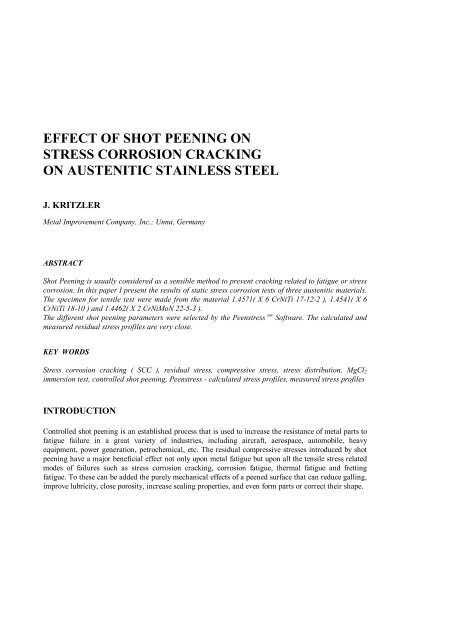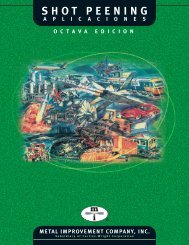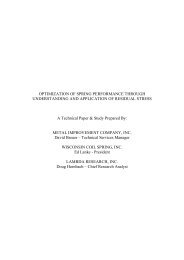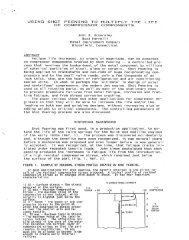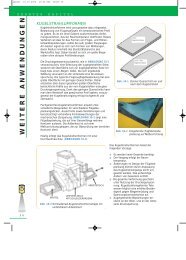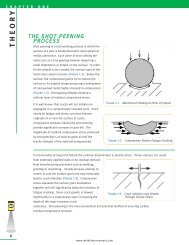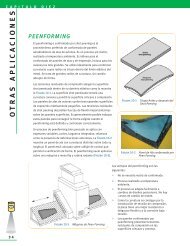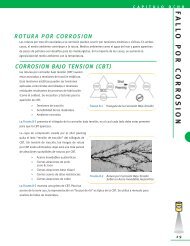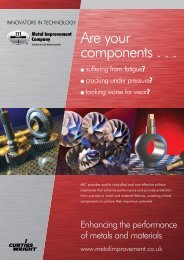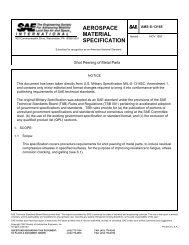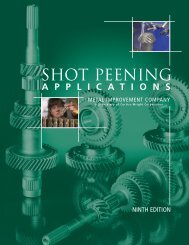Effect of Shot Peening on SCC of Austenitic - Metal Improvement ...
Effect of Shot Peening on SCC of Austenitic - Metal Improvement ...
Effect of Shot Peening on SCC of Austenitic - Metal Improvement ...
You also want an ePaper? Increase the reach of your titles
YUMPU automatically turns print PDFs into web optimized ePapers that Google loves.
EFFECT OF SHOT PEENING ON<br />
STRESS CORROSION CRACKING<br />
ON AUSTENITIC STAINLESS STEEL<br />
J. KRITZLER<br />
<strong>Metal</strong> <strong>Improvement</strong> Company, Inc.; Unna, Germany<br />
ABSTRACT<br />
<str<strong>on</strong>g>Shot</str<strong>on</strong>g> <str<strong>on</strong>g>Peening</str<strong>on</strong>g> is usually c<strong>on</strong>sidered as a sensible method to prevent cracking related to fatigue or stress<br />
corrosi<strong>on</strong>. In this paper I present the results <str<strong>on</strong>g>of</str<strong>on</strong>g> static stress corrosi<strong>on</strong> tests <str<strong>on</strong>g>of</str<strong>on</strong>g> three austenitic materials.<br />
The specimen for tensile test were made from the material 1.4571( X 6 CrNiTi 17-12-2 ), 1.4541( X 6<br />
CrNiTi 18-10 ) and 1.4462( X 2 CrNiMoN 22-5-3 ).<br />
The different shot peening parameters were selected by the Peenstress sm S<str<strong>on</strong>g>of</str<strong>on</strong>g>tware. The calculated and<br />
measured residual stress pr<str<strong>on</strong>g>of</str<strong>on</strong>g>iles are very close.<br />
KEY WORDS<br />
Stress corrosi<strong>on</strong> cracking ( <strong>SCC</strong> ), residual stress, compressive stress, stress distributi<strong>on</strong>, MgCl2<br />
immersi<strong>on</strong> test, c<strong>on</strong>trolled shot peening, Peenstress - calculated stress pr<str<strong>on</strong>g>of</str<strong>on</strong>g>iles, measured stress pr<str<strong>on</strong>g>of</str<strong>on</strong>g>iles<br />
INTRODUCTION<br />
C<strong>on</strong>trolled shot peening is an established process that is used to increase the resistance <str<strong>on</strong>g>of</str<strong>on</strong>g> metal parts to<br />
fatigue failure in a great variety <str<strong>on</strong>g>of</str<strong>on</strong>g> industries, including aircraft, aerospace, automobile, heavy<br />
equipment, power generati<strong>on</strong>, petrochemical, etc. The residual compressive stresses introduced by shot<br />
peening have a major beneficial effect not <strong>on</strong>ly up<strong>on</strong> metal fatigue but up<strong>on</strong> all the tensile stress related<br />
modes <str<strong>on</strong>g>of</str<strong>on</strong>g> failures such as stress corrosi<strong>on</strong> cracking, corrosi<strong>on</strong> fatigue, thermal fatigue and fretting<br />
fatigue. To these can be added the purely mechanical effects <str<strong>on</strong>g>of</str<strong>on</strong>g> a peened surface that can reduce galling,<br />
improve lubricity, close porosity, increase sealing properties, and even form parts or correct their shape.
It is an establihed fact that stress corrosi<strong>on</strong> cracking ( <strong>SCC</strong> ) <strong>on</strong>ly occurs in the presence <str<strong>on</strong>g>of</str<strong>on</strong>g> a critical<br />
state in the working material caused by enviroment c<strong>on</strong>diti<strong>on</strong>s and by sufficiently high tensile stress (<br />
Fig. 1 ). The residual stresses induced by the shot peening procedure will have a positive effect <strong>on</strong><br />
fatigue, <strong>on</strong> stress corrosi<strong>on</strong> cracking resulting from any oscillati<strong>on</strong> and <strong>on</strong> tensile crack corrosi<strong>on</strong> in the<br />
comp<strong>on</strong>ents.<br />
Material<br />
Compositi<strong>on</strong><br />
Heat Treatment<br />
Microstructure<br />
Fig. 1 Influence <str<strong>on</strong>g>of</str<strong>on</strong>g> critical states <strong>on</strong> material failures<br />
In chemical plants it is not possible to exert influence <strong>on</strong> the medium and thereby prevent stress<br />
corrosi<strong>on</strong> cracking. For this reas<strong>on</strong> the materials and the distributi<strong>on</strong> <str<strong>on</strong>g>of</str<strong>on</strong>g> residual stress were varied in the<br />
tests c<strong>on</strong>ducted.<br />
MATERIALS AND EXPERIMENTAL PROCEDURES<br />
Surface<br />
Compressive Residual Stress<br />
Fatigue<br />
Corrosi<strong>on</strong><br />
<strong>SCC</strong><br />
Stress<br />
Operating Stress<br />
Residual Stress<br />
Stress Rate<br />
Three typical materials, all used in chemical plants, were selected for the tests under laboratory<br />
c<strong>on</strong>diti<strong>on</strong>s.<br />
1.4571 X6 CrNiTi 17-12-2<br />
1.4541 X6 CrNiTi 18-10<br />
1.4462 X2 CrNiMoN 22-5-3<br />
From the chosen materials tensile strength specimens (proporti<strong>on</strong>al test bars ) were made for the stress<br />
corrosi<strong>on</strong> cracking test. An unpeened specimen was soluti<strong>on</strong> heated to reach a uniform starting states. The<br />
remaining specimens were then peened in line with three different shot peening parameters.<br />
The shot peening parameters were selected and optimised with the assistance <str<strong>on</strong>g>of</str<strong>on</strong>g> the Peenstress sm<br />
S<str<strong>on</strong>g>of</str<strong>on</strong>g>tware.<br />
Medium<br />
Corr.<br />
Fatigue<br />
Compositi<strong>on</strong><br />
Temperature<br />
Electrical<br />
Potential
Figure 2, below, shows the relati<strong>on</strong>ship between the basic shot peening parameters and the distributi<strong>on</strong><br />
<str<strong>on</strong>g>of</str<strong>on</strong>g> residual stress [ Source: B.Scholtes DGM 1980 ].<br />
Residual stress<br />
Tensi<strong>on</strong><br />
Compressi<strong>on</strong><br />
0<br />
[MPa]<br />
Distance from surface<br />
Fig. 2 <str<strong>on</strong>g>Shot</str<strong>on</strong>g> <str<strong>on</strong>g>Peening</str<strong>on</strong>g> Parameter vs. Residual Stress Distributi<strong>on</strong><br />
0<br />
H S<br />
H M<br />
H M<br />
v, d, H S , H M<br />
v, d, C, HS<br />
[mm]<br />
v: Velocity <str<strong>on</strong>g>of</str<strong>on</strong>g> S hot [m/s]<br />
d: S hot - size [mm]<br />
C: Coverage [% ]<br />
HS : Hardness <str<strong>on</strong>g>of</str<strong>on</strong>g> S hot [HRc]<br />
HM : Hardness <str<strong>on</strong>g>of</str<strong>on</strong>g> Material [HRc]<br />
The proporti<strong>on</strong>al test bars selected were processed in automated equipment and under full producti<strong>on</strong><br />
c<strong>on</strong>diti<strong>on</strong>s <strong>on</strong> the PEENAMATIC shot peening systems.<br />
The shot peening medium for all <str<strong>on</strong>g>of</str<strong>on</strong>g> the specimens was Stainless Steel Cut Wire ( SSCW ), size 0.8 mm,<br />
material 1.4310, hardness 610 – 670 HV1. The intensities were 5A, 12A and 20A. The degree <str<strong>on</strong>g>of</str<strong>on</strong>g><br />
coverage was uniform 100% for all specimens, and this was c<strong>on</strong>trolled by means <str<strong>on</strong>g>of</str<strong>on</strong>g> the PEENSCAN<br />
procedure.<br />
The following diagrams indicate the calculated distributi<strong>on</strong> <str<strong>on</strong>g>of</str<strong>on</strong>g> the residual stress <str<strong>on</strong>g>of</str<strong>on</strong>g> the various<br />
materials. The residual stress values were measured with the hole drilling method and they are denoted<br />
in each case by a small rectangle.
Res. Stress (MPa)<br />
Fig.: 3 Stress distributi<strong>on</strong> <str<strong>on</strong>g>of</str<strong>on</strong>g> material 1.4462<br />
Res. Stress (MPa)<br />
Fig.: 4 Stress distributi<strong>on</strong> <str<strong>on</strong>g>of</str<strong>on</strong>g> material 1.4462<br />
Residual Stress Distributi<strong>on</strong><br />
Residual Stress Distributi<strong>on</strong><br />
Depth (mm)<br />
Depth (mm)<br />
PEENSTRESS<br />
ENSAM - MIC<br />
5 A<br />
S 800 <str<strong>on</strong>g>Shot</str<strong>on</strong>g><br />
V = 9 m/s<br />
SS 1.4462<br />
s (MPa)<br />
m (MPa)<br />
P m(mm)<br />
P 0 (mm)<br />
Dir. Z<br />
12 A<br />
S 800 <str<strong>on</strong>g>Shot</str<strong>on</strong>g><br />
V = 33 m/s<br />
SS 1.4462<br />
s (MPa)<br />
m (MPa)<br />
P m(mm)<br />
P 0 (mm)<br />
- 588<br />
- 615<br />
0,025<br />
0,135<br />
PEENSTRESS<br />
ENSAM - MIC<br />
Dir. Z<br />
- 682<br />
- 720<br />
0,040<br />
0,315
Res. Stress (MPa)<br />
Fig.: 5 Stress distributi<strong>on</strong> <str<strong>on</strong>g>of</str<strong>on</strong>g> material 1.4462<br />
Res. Stress (MPa)<br />
Fig.: 6 Stress distributi<strong>on</strong> <str<strong>on</strong>g>of</str<strong>on</strong>g> material 1.4571<br />
Residual Stress Distributi<strong>on</strong><br />
Residual Stress Distributi<strong>on</strong><br />
Depth (mm)<br />
Depth (mm)<br />
20 A<br />
S 800 <str<strong>on</strong>g>Shot</str<strong>on</strong>g><br />
V = 69 m/s<br />
SS 1.4462<br />
s (MPa)<br />
m (MPa)<br />
P m(mm)<br />
P 0 (mm)<br />
PEENSTRESS<br />
ENSAM - MIC<br />
Dir. Z<br />
- 694<br />
- 742<br />
0,035<br />
0,490<br />
PEENSTRESS<br />
ENSAM - MIC<br />
5A<br />
S 800 <str<strong>on</strong>g>Shot</str<strong>on</strong>g><br />
V = 9 m/s<br />
SS 1.4571<br />
s (MPa)<br />
m (MPa)<br />
P m(mm)<br />
P 0 (mm)<br />
Dir. Z<br />
- 485<br />
- 523<br />
0,025<br />
0,170
Res. Stress (MPa)<br />
Fig.: 7 Stress distributi<strong>on</strong> <str<strong>on</strong>g>of</str<strong>on</strong>g> material 1.4571<br />
Res. Stress (MPa)<br />
Fig.: 8 Stress distributi<strong>on</strong> <str<strong>on</strong>g>of</str<strong>on</strong>g> material 1.4571<br />
Residual Stress Distributi<strong>on</strong><br />
Residual Stress Distributi<strong>on</strong><br />
Depth (mm)<br />
Depth (mm)<br />
20 A<br />
S 800 <str<strong>on</strong>g>Shot</str<strong>on</strong>g><br />
V = 69 m/s<br />
SS 1.4571<br />
s (MPa)<br />
m (MPa)<br />
P m(mm)<br />
P 0 (mm)<br />
PEENSTRESS<br />
ENSAM - MIC<br />
12 A<br />
S 800 <str<strong>on</strong>g>Shot</str<strong>on</strong>g><br />
V = 33 m/s<br />
SS 1.4571<br />
s (MPa)<br />
m (MPa)<br />
P m(mm)<br />
P 0 (mm)<br />
Dir. Z<br />
- 545<br />
- 579<br />
0,035<br />
0,390<br />
PEENSTRESS<br />
ENSAM - MIC<br />
Dir. Z<br />
- 543<br />
- 583<br />
0,020<br />
0,610
Res. Stress (MPa)<br />
Fig.: 9 Stress distributi<strong>on</strong> <str<strong>on</strong>g>of</str<strong>on</strong>g> material 1.4541<br />
Res. Stress (MPa)<br />
Fig.: 10 Stress distributi<strong>on</strong> <str<strong>on</strong>g>of</str<strong>on</strong>g> material 1.4541<br />
Residual Stress Distributi<strong>on</strong><br />
Residual Stress Distributi<strong>on</strong><br />
Depth (mm)<br />
Depth (mm)<br />
5 A<br />
S 800 <str<strong>on</strong>g>Shot</str<strong>on</strong>g><br />
V = 9 m/s<br />
SS 1.4541<br />
s (MPa)<br />
m (MPa)<br />
P m(mm)<br />
P 0 (mm)<br />
PEENSTRESS<br />
ENSAM - MIC<br />
Dir. Z<br />
- 481<br />
- 512<br />
0,025<br />
0,165<br />
12 A<br />
S 800 <str<strong>on</strong>g>Shot</str<strong>on</strong>g><br />
V = 33 m/s<br />
SS 1.4541<br />
s (MPa)<br />
m (MPa)<br />
P m(mm)<br />
P 0 (mm)<br />
PEENSTRESS<br />
ENSAM - MIC<br />
Dir. Z<br />
- 526<br />
- 563<br />
0,030<br />
0,380
Res. Stress (MPa)<br />
Fig. 11 Stress distributi<strong>on</strong> <str<strong>on</strong>g>of</str<strong>on</strong>g> material 1.4541<br />
Residual Stress Distributi<strong>on</strong><br />
Depth (mm)<br />
20 A<br />
S 800 <str<strong>on</strong>g>Shot</str<strong>on</strong>g><br />
V = 69 m/s<br />
SS 1.4541<br />
m (MPa)<br />
P m(mm)<br />
P 0 (mm)<br />
PEENSTRESS<br />
ENSAM - MIC<br />
s (MPa)<br />
The proporti<strong>on</strong>al test bars were fixed firmly in a holding device and tested statically for tensile strength.<br />
In total, four load c<strong>on</strong>diti<strong>on</strong>s at 50%, 70%, 80% and 90% <str<strong>on</strong>g>of</str<strong>on</strong>g> the yield points <str<strong>on</strong>g>of</str<strong>on</strong>g> the respective material<br />
were applied. The specimen were exposed to a 42%MgCl2 soluti<strong>on</strong> at a c<strong>on</strong>stant temperature <str<strong>on</strong>g>of</str<strong>on</strong>g> 145 o<br />
Celsius.<br />
Dir. Z<br />
- 542<br />
- 563<br />
0,020<br />
0,590
RESULTS AND DISCUSSION<br />
The following table displays the exposure times elapsing until the <strong>on</strong>set <str<strong>on</strong>g>of</str<strong>on</strong>g> the stress corrosi<strong>on</strong> cracking.<br />
Due to the limited time available for the tests not all permutati<strong>on</strong>s were tested. The tests were aborted<br />
after an exposure period in excess <str<strong>on</strong>g>of</str<strong>on</strong>g> 1,000 hours without any findings.<br />
Material <str<strong>on</strong>g>Shot</str<strong>on</strong>g> <str<strong>on</strong>g>Peening</str<strong>on</strong>g> Parameter Load<br />
50% 70% 80% 90%<br />
1.4541 not peened 11h 5h ---- 3,2h<br />
SSCW 0,8, 5A, 100% ---- ---- ---- ----<br />
SSCW 0,8, 12A, 100% ---- ---- ---- ----<br />
SSCW 0,8, 20A, 100% ---- >1000h ---- >1000h<br />
1.4571 not peened 17h 11,3h ---- 7,5h<br />
SSCW 0,8, 5A, 100% ---- ---- ---- ----<br />
SSCW 0,8, 12A, 100% ---- >1000h ---- >1000h<br />
SSCW 0,8, 20A, 100% ---- >1000h ---- >1000h<br />
1.4462 not peened 5,3h 3,3h ---- 1,3h<br />
SSCW 0,8, 5A, 100% ---- ---- ---- ----<br />
SSCW 0,8, 12A, 100% ---- >1000h >1000h 2h<br />
SSCW 0,8, 20A, 100% ---- >1000h >1000h 5,3h<br />
1.4529 not peened ---- 500h ---- 37h<br />
The results given here dem<strong>on</strong>strate clearly that c<strong>on</strong>trolled shot peening the materials significantly<br />
increases their resistance to stress corrosi<strong>on</strong> cracking in all three cases.<br />
On inspecti<strong>on</strong> <str<strong>on</strong>g>of</str<strong>on</strong>g> the exposure times <str<strong>on</strong>g>of</str<strong>on</strong>g> the unpeened specimens it is noted that the material 1.4462 has<br />
the lowest resistance to stress corrosi<strong>on</strong> cracking. The applicati<strong>on</strong> <str<strong>on</strong>g>of</str<strong>on</strong>g> c<strong>on</strong>trolled shot peening at a load <str<strong>on</strong>g>of</str<strong>on</strong>g><br />
70% the exposure time can be increased from 3.3 hours to over 1,000 hours. At 90% load the<br />
improvement is not so significant.<br />
The results for the material 1.4529 in a peened state are not yet available. The exposure times <str<strong>on</strong>g>of</str<strong>on</strong>g> 500<br />
hours and <str<strong>on</strong>g>of</str<strong>on</strong>g> 37 hours permit the c<strong>on</strong>clusi<strong>on</strong> that the shot peened versi<strong>on</strong> will generate also no findings.<br />
Even under high static loads the materials 1.4541 and 1.4571 display a marked improvement against<br />
stress corrosi<strong>on</strong> cracking. Because <str<strong>on</strong>g>of</str<strong>on</strong>g> the high testing times required <strong>on</strong>ly a few alternatives were<br />
investigated. Not even under high static loads did any damage occur, therefor it may be assumed that no<br />
premature damage needs to be anticipated at a reduced load earlier stage.<br />
The applicati<strong>on</strong> <str<strong>on</strong>g>of</str<strong>on</strong>g> c<strong>on</strong>trolled shot peening acquires special importance in the c<strong>on</strong>text <str<strong>on</strong>g>of</str<strong>on</strong>g> the producti<strong>on</strong><br />
costs.
The producti<strong>on</strong> costs for a 5,000 litre storage tank made <str<strong>on</strong>g>of</str<strong>on</strong>g> the material 1.4541 and including the cost <str<strong>on</strong>g>of</str<strong>on</strong>g><br />
shot peening would be approximately EUR 48,000. In case <str<strong>on</strong>g>of</str<strong>on</strong>g> making it from the material 1.4571, the<br />
producti<strong>on</strong> costs including shot peening would amount to EUR 50,000. The applicati<strong>on</strong> <str<strong>on</strong>g>of</str<strong>on</strong>g> the material<br />
1.4462 would increase the producti<strong>on</strong> costs to EUR 90,000 without including c<strong>on</strong>trolled shot peening.<br />
Cost <str<strong>on</strong>g>of</str<strong>on</strong>g> producti<strong>on</strong> [ EUR ]<br />
Fig.: 12 Cost Comparis<strong>on</strong> <str<strong>on</strong>g>of</str<strong>on</strong>g> 5000 liter tank<br />
CONCLUSION<br />
90000<br />
80000<br />
70000<br />
60000<br />
50000<br />
40000<br />
30000<br />
20000<br />
10000<br />
0<br />
1.4541 1.4571 1.4539 1.4462<br />
material<br />
Up to now tests have <strong>on</strong>ly been completed under static load.<br />
In plant c<strong>on</strong>structi<strong>on</strong> most comp<strong>on</strong>ents are under dynamic stress. In the future tests for corrosi<strong>on</strong> fatigue<br />
will be carried out.<br />
On the basis <str<strong>on</strong>g>of</str<strong>on</strong>g> the results obtained the findings will be put into practice.<br />
The investigati<strong>on</strong> into the producti<strong>on</strong> costs <str<strong>on</strong>g>of</str<strong>on</strong>g> a 5,000 litre storage tank revealed significant differences.<br />
For producing the tank from material 1.4541 or 1.4571 the cost for the c<strong>on</strong>trolled local shot peening at<br />
the site is already included.<br />
C<strong>on</strong>trolled shot peening will significantly increase the resistance to stress corrosi<strong>on</strong> cracking. Earlier<br />
research c<strong>on</strong>firms the above findings in respect <str<strong>on</strong>g>of</str<strong>on</strong>g> ferritic base materials and in NH3 media.<br />
On the basis <str<strong>on</strong>g>of</str<strong>on</strong>g> the present results less expensive materials may be used in plant the c<strong>on</strong>structi<strong>on</strong> or in<br />
chemical plant without impairing the resistance to corrosi<strong>on</strong>.


